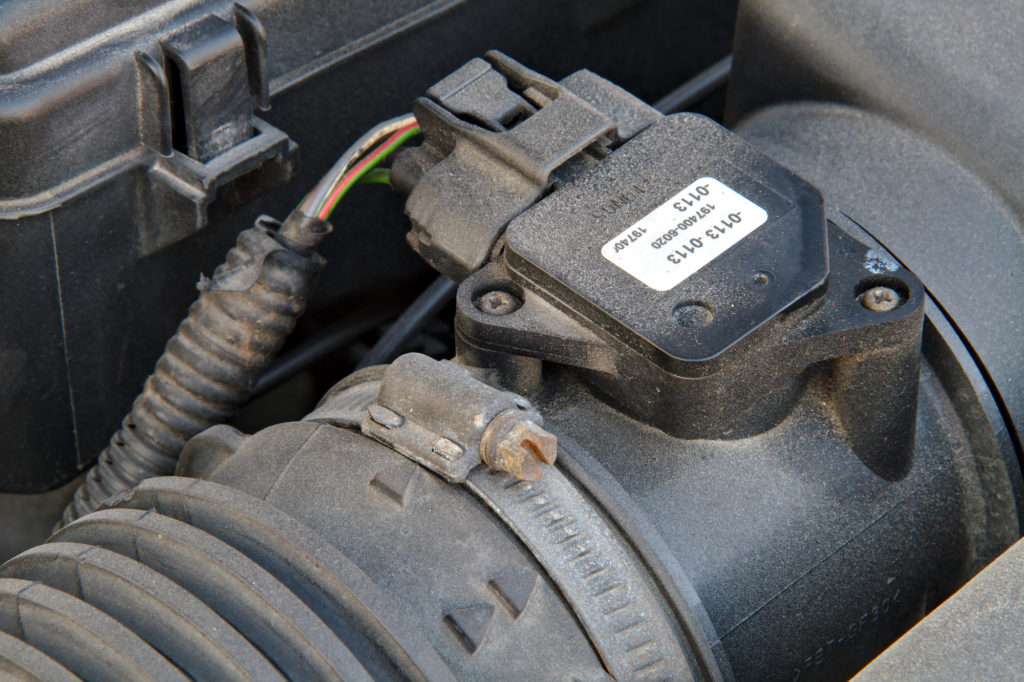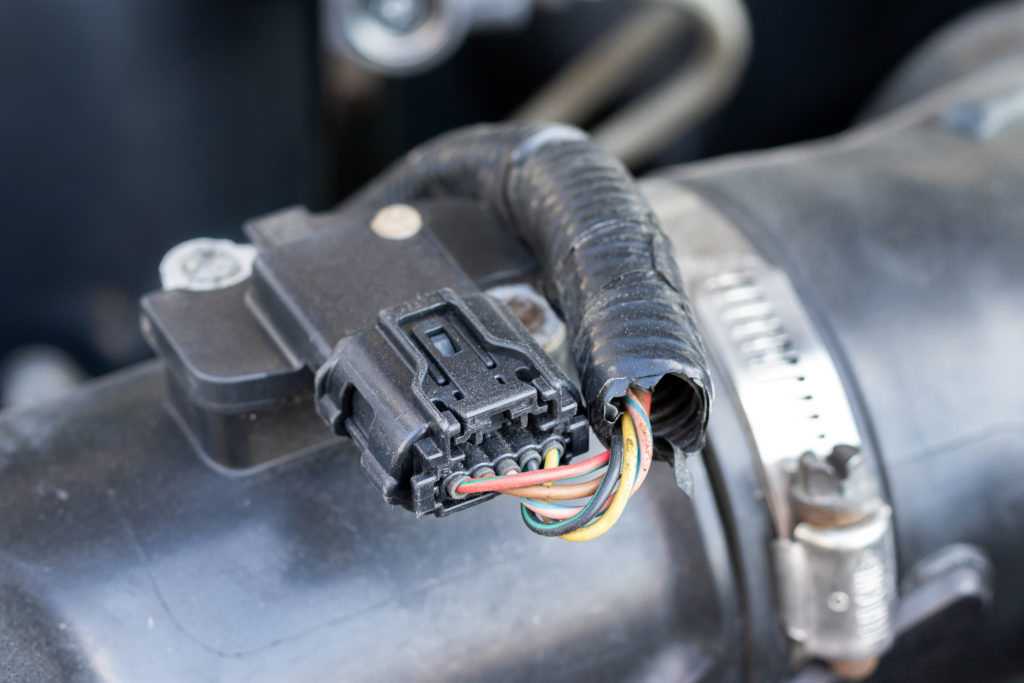If you’re having problems with your car’s engine, it could be due to a bad air flow sensor. Learn about the symptoms of a bad air flow sensor, the causes, and what it costs to have it replaced.

Contents
What Is a Mass Air Flow Sensor?
A mass airflow sensor is an integral part of a vehicle’s engine. It determines the mass flow rate of the air entering fuel-injected internal combustion engines.
This measurement and information are essential for the engine’s control unit to monitor to ensure a balanced delivery of fuel mass into the engine.
Air density changes when temperature and pressure change, so the airflow rate fluctuates often when the engine runs.
Most modern air flow sensors utilize a hot wire and a temperature gauge to monitor the temperature of the air around the wire. The more power the engine uses, the higher the temperature rises.
Mass Air Flow Sensor Location
The mass air flow sensor is between your car’s air filter and the intake manifold of the engine.
Mass Air Flow Sensor Problems
When problems arise with this piece of equipment, it can result in some troubling engine activity.
When you have an issue with your mass air flow sensor, the airflow readings it provides will not be accurate.
You can tell they are inaccurate if the reading does not change when the car goes from idling to engine revolutions.
To tell when the mass air flow sensor needs attention, you’ll need to check the readings and know what a normal reading should look like.
Common symptoms of a bad mass air flow sensor include a lack of power, poor acceleration, check engine light, rough idling, no-start, stalling, and issues with your automatic transmission.
We’ll cover them in-depth below.
What Is a Normal Mass Air Flow Sensor Reading?
The expected mass air flow sensor reading will differ depending on the size of the engine. But the standard air flow reading should be 2 to 7 grams per second (g/s) when the engine is idling.
The air flow reading should rise to 15 to 25 grams per second at 2500 revolutions per minute (rpm).
Symptoms of a Bad Mass Air Flow Sensor
If you suspect a faulty air flow sensor, there are a few symptoms to watch out for. Bear in mind these symptoms can also indicate other engine problems, but they’re characteristic of a mass air flow sensor, and you can rule out the sensor by taking a reading.
Below are common symptoms to keep an eye out for if you suspect there’s something wrong with your mass air flow sensor.
Lack of Power or Poor Acceleration
If the car struggles to accelerate and there feels like a lack of power, it could be because the air flow sensor is faulty or dirty.
When this happens, the engine can’t properly accelerate because it doesn’t know the amount of air moving through it.
Check Engine Light
A classic symptom of car problems is if your “check engine” light or “service engine soon” light comes on. It could be indicating your mass air flow sensor needs to be replaced or cleaned.
If that light comes on, always be sure to get it checked out ASAP to avoid further damages to your vehicle.
Automatic Transmission Problems
If your automatic car struggles to switch gears, it may be due to the air flow sensor improperly reading the amount of air moving through the engine.
The sensor plays an integral role in gear shifting as more air flowing indicates to the engine that you need to go up a gear.
Rough Idling
If the engine idling is not a consistent and steady hum or rumbling, the air flow sensor may be on the fritz.
A rough and inconsistent idling where the engine sputters and seems to struggle can mean the air flow sensor readings change too quickly, affecting how the engine runs.
No-Start
If you can’t get your car to turn on, the mass air flow sensor may be to blame. If the sensor reads there is too much air flow, it can prevent the engine from starting altogether.
Stalling
If your car is frequently stalling and you can’t determine any other causes, it could be because the readings on the air sensor are fluctuating too much, causing the engine to stall.
 air filter collapses or becomes dislodged, the sensor and engine will get much dirtier and become contaminated, requiring you to either replace the filter or replace the sensor altogether. Replacing the filter can be difficult and result in damage to the sensor itself, so a complete replacement is often the best solution. Over-Soaked Air Filter Some air flow sensors have washable filters. These washable filters are convenient because you can keep the sensor in good condition for longer and avoid contamination. However, if the air filter is still wet when you replace it in the engine, then air cannot properly flow through the sensor. Therefore, the sensor cannot accurately read the amount of air moving through it, causing your engine to misbehave and sputter. How to Reset Mass Air Flow Sensor All you need to do to reset the air flow sensor is unplug the car’s battery for ten minutes or more, then plug it back in! It’s super simple, and this could fix your air flow sensor if it is just a minor problem with the reading mechanism. Can You Drive With a Bad Mass Air Flow Sensor? While the engine will behave strangely, with inconsistent fuel being delivered to the combustion chamber, you can technically still drive. But driving with a bad air flow sensor typically leads to more engine problems. If you don’t take care of the air flow sensor issues, other parts of your engine may fall into disrepair, costing you more money in the long run. Mass Air Flow Sensor Price A mass air flow sensor usually costs between $100 and $150. But some can cost up to $400, depending on the make and model of the car. Mass Air Flow Sensor Replacement Cost A damaged or contaminated air flow sensor may need to be replaced. Luckily, it’s not a super costly or complicated task. But most people will need to take their vehicle to a mechanic to determine the severity of the damage or contamination. If it is dirty, your mechanic may be able to clean it, so it works again. However, most of the time, the sensor needs to be replaced, and this is a very delicate procedure, although simple. The necessary replacement parts and labor can cost anywhere between $100 and $450, depending on the car’s make and model. The parts are the most expensive part, while the labor for this usually only costs $25 to $50. The most important aspect of replacing the air flow sensor if you try to do it yourself is to have the air filter installed and handle all parts very gently.” class=”wp-image-2447″/>
air filter collapses or becomes dislodged, the sensor and engine will get much dirtier and become contaminated, requiring you to either replace the filter or replace the sensor altogether. Replacing the filter can be difficult and result in damage to the sensor itself, so a complete replacement is often the best solution. Over-Soaked Air Filter Some air flow sensors have washable filters. These washable filters are convenient because you can keep the sensor in good condition for longer and avoid contamination. However, if the air filter is still wet when you replace it in the engine, then air cannot properly flow through the sensor. Therefore, the sensor cannot accurately read the amount of air moving through it, causing your engine to misbehave and sputter. How to Reset Mass Air Flow Sensor All you need to do to reset the air flow sensor is unplug the car’s battery for ten minutes or more, then plug it back in! It’s super simple, and this could fix your air flow sensor if it is just a minor problem with the reading mechanism. Can You Drive With a Bad Mass Air Flow Sensor? While the engine will behave strangely, with inconsistent fuel being delivered to the combustion chamber, you can technically still drive. But driving with a bad air flow sensor typically leads to more engine problems. If you don’t take care of the air flow sensor issues, other parts of your engine may fall into disrepair, costing you more money in the long run. Mass Air Flow Sensor Price A mass air flow sensor usually costs between $100 and $150. But some can cost up to $400, depending on the make and model of the car. Mass Air Flow Sensor Replacement Cost A damaged or contaminated air flow sensor may need to be replaced. Luckily, it’s not a super costly or complicated task. But most people will need to take their vehicle to a mechanic to determine the severity of the damage or contamination. If it is dirty, your mechanic may be able to clean it, so it works again. However, most of the time, the sensor needs to be replaced, and this is a very delicate procedure, although simple. The necessary replacement parts and labor can cost anywhere between $100 and $450, depending on the car’s make and model. The parts are the most expensive part, while the labor for this usually only costs $25 to $50. The most important aspect of replacing the air flow sensor if you try to do it yourself is to have the air filter installed and handle all parts very gently.” class=”wp-image-2447″/>Mass Air Flow Sensor Failure Causes
There are a few different causes of a bad air flow sensor. You can avoid some of these, but others are just a normal part of an engine’s life. Below are the five common causes of mass air flow sensor failure.
Damage
If the air flow sensor is damaged, whether in an accident or due to long-term wear and tear, it will need to be replaced. Air flow sensors are delicate, and repairing one is practically impossible, so it needs replacing if it has taken any damage.
Contamination
A contaminated mass air flow sensor means your mass air flow sensor is dirty. The contamination can be debris, dust, grease, and other substances that travel through the engine often and get trapped in the sensor.
Mass air flow sensors can be cleaned very carefully, but often, this is only a temporary solution, and it’s better to replace them.
Improperly Installed Air Filter
An air flow sensor delivering strange and false readings may have been installed improperly. A mechanic will easily be able to diagnose this problem, and if there’s no damage to the sensor, they can probably reinstall it for a small labor cost.
Collapsed Air Filter
Every mass air flow sensor has a filter which helps keep the sensor and the engine cleaner for longer.
If the air filter collapses or becomes dislodged, the sensor and engine will get much dirtier and become contaminated, requiring you to either replace the filter or replace the sensor altogether.
Replacing the filter can be difficult and result in damage to the sensor itself, so a complete replacement is often the best solution.
Over-Soaked Air Filter
Some air flow sensors have washable filters. These washable filters are convenient because you can keep the sensor in good condition for longer and avoid contamination.
However, if the air filter is still wet when you replace it in the engine, then air cannot properly flow through the sensor. Therefore, the sensor cannot accurately read the amount of air moving through it, causing your engine to misbehave and sputter.
How to Reset Mass Air Flow Sensor
All you need to do to reset the air flow sensor is unplug the car’s battery for ten minutes or more, then plug it back in! It’s super simple, and this could fix your air flow sensor if it is just a minor problem with the reading mechanism.
Can You Drive With a Bad Mass Air Flow Sensor?
While the engine will behave strangely, with inconsistent fuel being delivered to the combustion chamber, you can technically still drive.
But driving with a bad air flow sensor typically leads to more engine problems.
If you don’t take care of the air flow sensor issues, other parts of your engine may fall into disrepair, costing you more money in the long run.
Mass Air Flow Sensor Price
A mass air flow sensor usually costs between $100 and $150. But some can cost up to $400, depending on the make and model of the car.
Mass Air Flow Sensor Replacement Cost
A damaged or contaminated air flow sensor may need to be replaced. Luckily, it’s not a super costly or complicated task.
But most people will need to take their vehicle to a mechanic to determine the severity of the damage or contamination.
If it is dirty, your mechanic may be able to clean it, so it works again. However, most of the time, the sensor needs to be replaced, and this is a very delicate procedure, although simple.
The necessary replacement parts and labor can cost anywhere between $100 and $450, depending on the car’s make and model.
The parts are the most expensive part, while the labor for this usually only costs $25 to $50.
The most important aspect of replacing the air flow sensor if you try to do it yourself is to have the air filter installed and handle all parts very gently.











